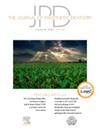Evaluating the effects of splinting implant scan bodies intraorally on the trueness of complete arch digital scans: A clinical study
IF 4.3
2区 医学
Q1 DENTISTRY, ORAL SURGERY & MEDICINE
引用次数: 0
Abstract
Statement of problem
A predictable protocol for accurately scanning implants in a complete edentulous arch has not been established.
Purpose
The purpose of this clinical study was to investigate the effect of splinting implant scan bodies intraorally on the accuracy and scan time for digital scans of edentulous arches.
Material and methods
This single center, nonrandomized, clinical trial included a total of 19 arches. Definitive casts with scan bodies were fabricated and scanned with a laboratory scanner as the reference (control) scan. Each participant received 2 intraoral scans, the first with unsplinted scan bodies and the second with resin-splinted scan bodies. The scan time was also recorded for each scan. To compare the accuracy of the scans, the standard tessellation language (STL) files of the 2 scans were superimposed on the control scan, and positional and angular deviations were analyzed by using a 3-dimensional (3D) metrology software program. The Mann-Whitney U test was used to compare the distance and angular deviations between the splinted group and the unsplinted group with the control. The ANOVA test was conducted to examine the effect of the scan technique on trueness (distance deviation and angular deviation) and scan time (α=.05 for all tests).
Results
Statistically significant differences were found in the overall 3D positional and angular deviations of the unsplinted and splinted digital scans when compared with the reference scans (P<.05). No statistically significant differences in overall 3-dimensional positional deviations (P=.644) and angular deviations (P=.665) were found between the splinted and unsplinted experimental groups. A faster scan time was found with the splinted group in the maxillary arch.
Conclusions
Conventional complete arch implant impressions were more accurate than digital complete arch implant scans. Splinting implant scan bodies did not significantly affect the trueness of complete arch digital scans, but splinting appeared to reduce the scan time. However, fabricating the splint was not considered in the time measurement.
评估在口腔内夹持种植体扫描体对全牙弓数字扫描真实性的影响:临床研究。
这项临床研究的目的是调查在口腔内夹持种植体扫描体对无牙颌牙弓数字扫描的准确性和扫描时间的影响。材料和方法这项单中心、非随机临床试验共包括 19 个牙弓。使用实验室扫描仪作为参考(对照)扫描,制作带有扫描体的最终铸模并进行扫描。每位受试者都接受了两次口内扫描,第一次使用未粘接的扫描体,第二次使用树脂粘接的扫描体。每次扫描的扫描时间也被记录下来。为了比较扫描的准确性,将 2 次扫描的标准细分语言(STL)文件叠加到对照扫描上,并使用三维(3D)计量软件程序分析位置和角度偏差。使用 Mann-Whitney U 检验比较夹板组和未夹板组与对照组之间的距离和角度偏差。结果未夹板组和夹板数字扫描的整体三维位置偏差和角度偏差与参照扫描相比有显著统计学差异(P<.05)。夹板实验组和非夹板实验组在整体三维位置偏差(P=.644)和角度偏差(P=.665)方面没有发现明显的统计学差异。结论传统的全牙弓种植体印模比数字化全牙弓种植体扫描更准确。对种植体扫描体进行夹板固定并不会明显影响全牙弓数字化扫描的准确性,但夹板固定似乎可以缩短扫描时间。但是,时间测量中并没有考虑夹板的制作。
本文章由计算机程序翻译,如有差异,请以英文原文为准。
求助全文
约1分钟内获得全文
求助全文
来源期刊

Journal of Prosthetic Dentistry
医学-牙科与口腔外科
CiteScore
7.00
自引率
13.00%
发文量
599
审稿时长
69 days
期刊介绍:
The Journal of Prosthetic Dentistry is the leading professional journal devoted exclusively to prosthetic and restorative dentistry. The Journal is the official publication for 24 leading U.S. international prosthodontic organizations. The monthly publication features timely, original peer-reviewed articles on the newest techniques, dental materials, and research findings. The Journal serves prosthodontists and dentists in advanced practice, and features color photos that illustrate many step-by-step procedures. The Journal of Prosthetic Dentistry is included in Index Medicus and CINAHL.
 求助内容:
求助内容: 应助结果提醒方式:
应助结果提醒方式:


